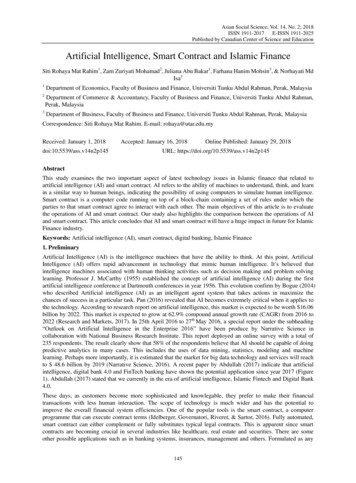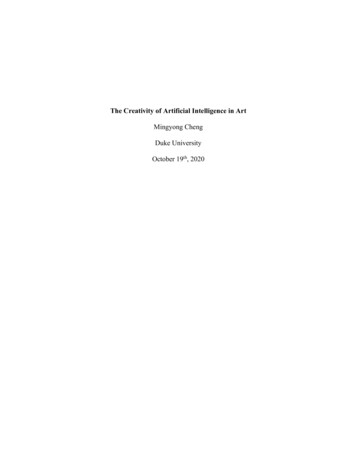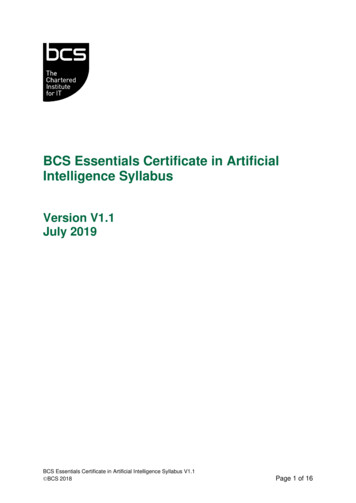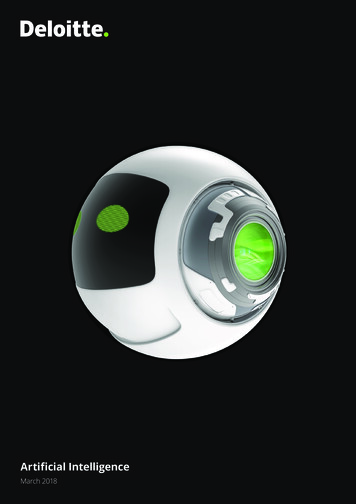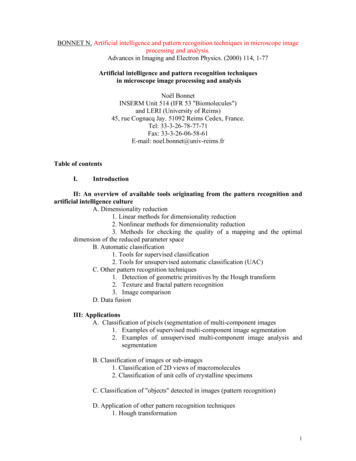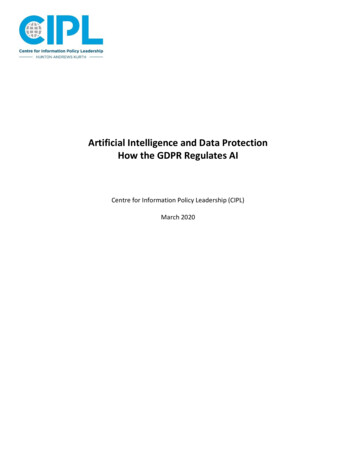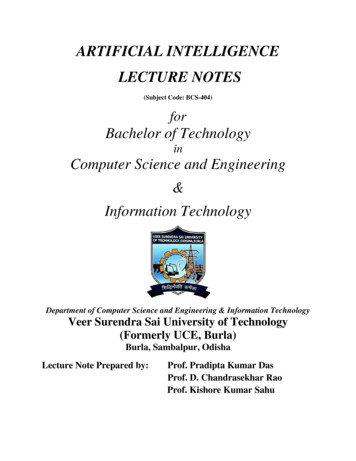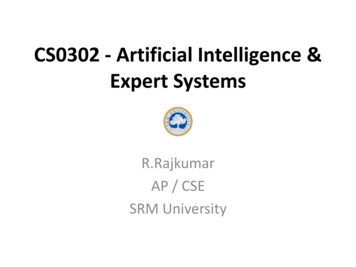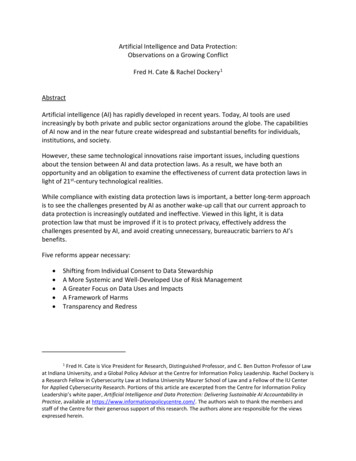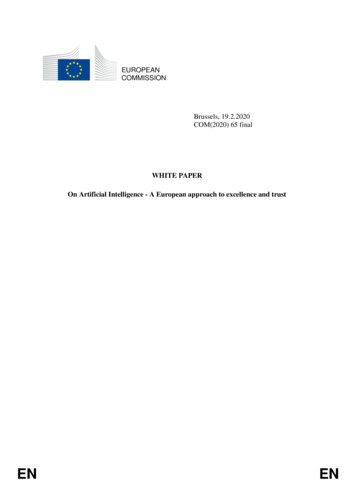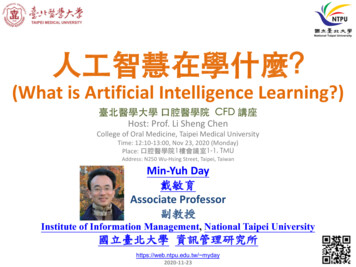
Transcription
(What is Artificial Intelligence Learning?),Host: Prof. Li Sheng Chen1College of Oral Medicine, Taipei Medical UniversityTime: 12:10-13:00, Nov 23, 2020 (Monday)Place:Address: N250 Wu-Hsing Street, Taipei, TaiwanMin-Yuh DayAssociate ProfessorInstitute of Information Management, National Taipei Universityhttps://web.ntpu.edu.tw/ myday2020-11-231
(Min-Yuh Day, Ph.D.)Publications Co-Chairs, IEEE/ACM International Conference onAdvances in Social Networks Analysis and Mining (ASONAM 2013- )Program Co-Chair, IEEE International Workshop onEmpirical Methods for Recognizing Inference in TExt (IEEE EM-RITE 2012- )Publications Chair, The IEEE International Conference onInformation Reuse and Integration (IEEE IRI)2
Outline Artificial Intelligence Machine Learning Deep Learning AI in Medicine3
Stuart Russell and Peter Norvig (2020),Artificial Intelligence: A Modern Approach,4th Edition, PearsonSource: Stuart Russell and Peter Norvig (2020), Artificial Intelligence: A Modern Approach, 4th Edition, nce-A-Modern-Approach/dp/0134610997/4
with limited resources. Such decision support models were typically called operationsresearch (OR). The problems that were too complex to solve optimally (using linear ornonlinear mathematical programming techniques) were tackled using heuristic methodssuch as simulation models. (We will introduce these as prescriptive analytics later in thischapter and in a bit more detail in Chapter 6.)In the late 1970s and early 1980s, in addition to the mature OR models that werebeing used in many industries and government systems, a new and exciting line of models had emerged: rule-based expert systems. These systems promised to capture experts’knowledge in a format that computers could AIprocess (via a collection of if–then–else rulesor heuristics) so that these could be used for consultation much the same way that oneAI, Big Data, Cloud ComputingEvolution of Decision Support,Business Intelligence, and AnalyticsAICloud ComputingOEnExeBig DataSocDM BIiacuteDlNDrtaIipsevCnrishbem-M etwloisioaBIueondusdD ar nfoBi em orkRR AI/ n SCRDradeiorgou E/Mmupom at neta ssoel StaDyatin xpsa&edp,uatatWsputio ticiorc/TIne ert ortSIaantn-D ia Aexna RecRritnAoSSSehPlepg, t M elll D eprenana atysaoiabor yst ystogcSlnuBtyerainisiaa nintin em emtic as lyticM tinncrd emnnSSgeggeggssssssDecn-1970sDecision Support SystemsFIGURE 1.81980sEnterprise/Executive IS1990s2000sBusiness Intelligence2010sAnalyticsBig Data .Evolution of Decision Support, Business Intelligence, and Analytics.Source: Ramesh Sharda, Dursun Delen, and Efraim Turban (2017),Business Intelligence, Analytics, and Data Science: A Managerial Perspective, 4th Edition, Pearson5
Artificial Intelligence (A.I.) TimelineSource: and-beyond/6
Countless working definitions of AI have been proposedChinese game of Go, and the defeat of reigning worldover the years but the unifying thread in all of them ischampion Lee Sedol by DeepMind’s AlphaGo in March 2016.The Rise of AITHE RISE OF AIAI is bornFocus on specific intelligenceThe Turing TestDartmouth College conferenceInformation theory-digital signalsSymbolic reasoningDartmouth conferenceled by John McCarthycoins the term"artificial intelligence"Edward Feigenbaumdevelops the firstExpert System,giving rebirth to AI19561975 – 1982Focus on specific problemsExpert systems & knowledgeNeural networks conceptualizedOptical character recognitionSpeech recognitionMachine learningDeep learning: pattern analysis & classificationBig data: large databasesFast processors to crunch dataHigh-speed networks and connectivityIBM's Watson Q&A machine wins Jeopardy!Apple integrates Siri, a personal voiceassistant into the iPhone20111960197019801990AlphaGodefeats Lee Sedol2014YouTube recognizescats from videos2000195020162010202019971964IBM's Deep Blue defeatsGarry Kasparov, the world'sreigning chess championEliza, the first chatbotis developed by JosephWeizenbaum at MITLimited computer processing powerLimited database storage capacityLimited network abilityReal-world problems are complicatedFacial recognition, translationCombinatorial explosionAI Winter IDisappointing results: failure to achieve scaleCollapse of dedicated hardware vendorsAI Winter IIFigure 1: An AI timeline; Source: Lavenda, D. / Marsden, P.Source: DHL (2018), Artificial Intelligence in oad/doc con/5e50c53c5bf67.pdf/7
Artificial Intelligence in MedicineSource: Vivek Kaul, Sarah Enslin, and Seth A. Gross (2020), "The history of artificial intelligence in medicine." Gastrointestinal endoscopy.8
AI9
DefinitionofArtificial Intelligence(A.I.)10
Artificial Intelligence“ the science andengineeringofmakingintelligent machines”(John McCarthy, 1955)Source: ons-from-business-and-science/11
Artificial Intelligence“ technology thatthinks and actslike humans”Source: ons-from-business-and-science/12
Artificial Intelligence“ intelligenceexhibited by machinesor software”Source: ons-from-business-and-science/13
4 Approaches of AIThinking HumanlyThinking RationallyActing HumanlyActing RationallySource: Stuart Russell and Peter Norvig (2020), Artificial Intelligence: A Modern Approach, 4th Edition, Pearson14
4 Approaches of AI2.Thinking Humanly:The CognitiveModeling Approach1.Acting Humanly:The Turing TestApproach(1950)3.Thinking Rationally:The “Laws of Thought”Approach4.Acting Rationally:The Rational AgentApproachSource: Stuart Russell and Peter Norvig (2020), Artificial Intelligence: A Modern Approach, 4th Edition, Pearson15
AI Acting Humanly:The Turing Test Approach(Alan Turing, 1950) Knowledge Representation Automated Reasoning Machine Learning (ML)– Deep Learning (DL) Computer Vision (Image, Video) Natural Language Processing (NLP) RoboticsSource: Stuart Russell and Peter Norvig (2020), Artificial Intelligence: A Modern Approach, 4th Edition, Pearson16
Artificial Intelligence:A Modern Approach1.2.3.4.5.6.7.Artificial IntelligenceProblem SolvingKnowledge and ReasoningUncertain Knowledge and ReasoningLearningCommunicating, Perceiving, and ActingPhilosophy and Ethics of AISource: Stuart Russell and Peter Norvig (2020), Artificial Intelligence: A Modern Approach, 4th Edition, Pearson17
Artificial Intelligence:Intelligent AgentsSource: Stuart Russell and Peter Norvig (2020), Artificial Intelligence: A Modern Approach, 4th Edition, Pearson18
Artificial Intelligence:2. Problem Solving Solving Problems by SearchingSearch in Complex EnvironmentsAdversarial Search and GamesConstraint Satisfaction ProblemsSource: Stuart Russell and Peter Norvig (2020), Artificial Intelligence: A Modern Approach, 4th Edition, Pearson19
Artificial Intelligence:3. Knowledge and Reasoning Logical AgentsFirst-Order LogicInference in First-Order LogicKnowledge RepresentationAutomated PlanningQuantifying UncertaintySource: Stuart Russell and Peter Norvig (2020), Artificial Intelligence: A Modern Approach, 4th Edition, Pearson20
Artificial Intelligence:4. Uncertain Knowledge and Reasoning Probabilistic ReasoningProbabilistic Reasoning over TimeProbabilistic ProgrammingMaking Simple DecisionsMaking Complex DecisionsSource: Stuart Russell and Peter Norvig (2020), Artificial Intelligence: A Modern Approach, 4th Edition, Pearson21
Artificial Intelligence:5. Learning Multiagent Decision MakingLearning from ExamplesLearning Probabilistic ModelsDeep LearningSource: Stuart Russell and Peter Norvig (2020), Artificial Intelligence: A Modern Approach, 4th Edition, Pearson22
Artificial Intelligence:6. Communicating, Perceiving, and Acting Reinforcement Learning Natural Language Processing Deep Learning for Natural LanguageProcessing RoboticsSource: Stuart Russell and Peter Norvig (2020), Artificial Intelligence: A Modern Approach, 4th Edition, Pearson23
Artificial Intelligence:Philosophy and Ethics of AIThe Future of AISource: Stuart Russell and Peter Norvig (2020), Artificial Intelligence: A Modern Approach, 4th Edition, Pearson24
AI in Medicine AI algorithms now equal or exceedexpert doctors at diagnosing many conditions,particularly when the diagnosis is based onimages. Examples:– Alzheimer’s disease (Ding et al., 2018)– Metastatic cancer (Liu et al., 2017; Esteva et al., 2017)– Ophthalmic disease (Gulshan et al., 2016)– Skin diseases (Liu et al., 2019c)Source: Stuart Russell and Peter Norvig (2020), Artificial Intelligence: A Modern Approach, 4th Edition, Pearson25
AI in Medicine A systematic review and meta-analysis (Liu etal., 2019a) found that the performance of AIprograms, on average, was equivalent to healthcare professionals. One current emphasis in medical AI is infacilitating human–machine partnerships.– For example, the LYNA system achieves 99.6%overall accuracy in diagnosing metastatic breastcancer—better than an unaided human expert—butthe combination does better still (Liu et al., 2018;Steiner et al., 2018).Source: Stuart Russell and Peter Norvig (2020), Artificial Intelligence: A Modern Approach, 4th Edition, Pearson26
AI in Medicine The widespread adoption of these techniques isnow limited not by diagnostic accuracy but bythe need to demonstrate improvement inclinical outcomes and to ensure transparency,lack of bias, and data privacy (Topol, 2019). In 2017, only two medical AI applications wereapproved by the FDA, but that increased to 12in 2018, and continues to rise.Source: Stuart Russell and Peter Norvig (2020), Artificial Intelligence: A Modern Approach, 4th Edition, Pearson27
3 Machine Learning AlgorithmsSource: Enrico Galimberti, -learning-algorithms/28
Artificial IntelligenceMachine Learning & Deep LearningSource: eep-learning-ai/29
AI, ML, DLArtificial Intelligence (AI)Machine Learning (ML)SupervisedLearningUnsupervisedLearningDeep Learning (DL)CNNRNN LSTM Source: l-inteligence/content/deep learning.html30
3 Machine Learning AlgorithmsSource: Enrico Galimberti, -learning-algorithms/31
Can a robot pass a university entrance exam?Noriko Arai at TED2017https://www.ted.com/talks/noriko arai can a robot pass a university entrance examhttps://www.youtube.com/watch?v XQZjkPyJ8KU32
Machine Learning (ML) / Deep Learning (DL)SupervisedLearningMachineLearning(ML)Decision port VectorMachine (SVM)Neural Network(NN)Deep Learning(DL)Naïve Bayes(NB)BayesianNetwork (BN)MaximumEntropy (ME)ReinforcementLearningSource: Jesus Serrano-Guerrero, Jose A. Olivas, Francisco P. Romero, and Enrique Herrera-Viedma (2015),"Sentiment analysis: A review and comparative analysis of web services," Information Sciences, 311, pp. 18-38.33
Computer Vision: Image Classification,Object Detection,Object Instance SegmentationSource: DHL (2018), Artificial Intelligence in oad/doc con/5e50c53c5bf67.pdf/34
Computer Vision: Object DetectionSource: Li Liu, Wanli Ouyang, Xiaogang Wang, Paul Fieguth, Jie Chen, Xinwang Liu, and Matti Pietikäinen. "Deep learning for genericobject detection: A survey." International journal of computer vision 128, no. 2 (2020): 261-318.35
YOLOv4:Optimal Speed and Accuracy of Object DetectionSource: Alexey Bochkovskiy, Chien-Yao Wang, and Hong-Yuan Mark Liao. "YOLOv4: Optimal Speed and Accuracy of Object Detection."arXiv preprint arXiv:2004.10934 (2020).36
Labelling strategies for differentdental image modalitiesNear Infrared-Light TransilluminationSource: Falk Schwendicke, Tatiana Golla, Martin Dreher, and Joachim Krois. "Convolutional neural networks for dental imagediagnostics: A scoping review." Journal of Dentistry 91 (2019): 103226.37
Scope and Performance ofArtificial Intelligence Technologyin Orthodontic Diagnosis,Treatment Planning, andClinical Decision-making –A Systematic ReviewJournal of Dental Sciences (2020)Source:Sanjeev B. Khanagar, Ali Al-Ehaideb, Satish Vishwanathaiah, Prabhadevi C.Maganur, Shankargouda Patil, Sachin Naik, Hosam A. Baeshen, and Sachin S.Sarode (2020). "Scope and performance of artificial intelligence technology inorthodontic diagnosis, treatment planning, and clinical decision-making-A systematicreview." Journal of Dental Sciences.38
Artificial Intelligence Technology in Orthodontic Diagnosis,Treatment Planning, and Clinical Decision-MakingSource: Sanjeev B. Khanagar, Ali Al-Ehaideb, Satish Vishwanathaiah, Prabhadevi C. Maganur, Shankargouda Patil, Sachin Naik, Hosam A.Baeshen, and Sachin S. Sarode (2020). "Scope and performance of artificial intelligence technology in orthodontic diagnosis, treatmentplanning, and clinical decision-making-A systematic review." Journal of Dental Sciences.39
Artificial Intelligence Technology in Orthodontic Diagnosis,Treatment Planning, and Clinical Decision-MakingSource: Sanjeev B. Khanagar, Ali Al-Ehaideb, Satish Vishwanathaiah, Prabhadevi C. Maganur, Shankargouda Patil, Sachin Naik, Hosam A.Baeshen, and Sachin S. Sarode (2020). "Scope and performance of artificial intelligence technology in orthodontic diagnosis, treatmentplanning, and clinical decision-making-A systematic review." Journal of Dental Sciences.40
Artificial Intelligence Technology in Orthodontic Diagnosis,Treatment Planning, and Clinical Decision-MakingSource: Sanjeev B. Khanagar, Ali Al-Ehaideb, Satish Vishwanathaiah, Prabhadevi C. Maganur, Shankargouda Patil, Sachin Naik, Hosam A.Baeshen, and Sachin S. Sarode (2020). "Scope and performance of artificial intelligence technology in orthodontic diagnosis, treatmentplanning, and clinical decision-making-A systematic review." Journal of Dental Sciences.41
Artificial Intelligence Technology in Orthodontic Diagnosis,Treatment Planning, and Clinical Decision-MakingSource: Sanjeev B. Khanagar, Ali Al-Ehaideb, Satish Vishwanathaiah, Prabhadevi C. Maganur, Shankargouda Patil, Sachin Naik, Hosam A.Baeshen, and Sachin S. Sarode (2020). "Scope and performance of artificial intelligence technology in orthodontic diagnosis, treatmentplanning, and clinical decision-making-A systematic review." Journal of Dental Sciences.42
Comparing latest deep-CNN based systems foridentifying cephalometric landmarks (Park et al., 2019) CNNs Comparing latest deep-CNN based systems for identifyingcephalometric landmarks 283 Landmarks Cephalometric radiographs Single Shot Multibox Detector (SSD) 5% higher accuracy with (YOLOv3) than Single (SSD) ( )Effective You-Only-Look-Once model outperformed in accuracy andcomputational time than the Shot Multibox Detector This model can be used in clinical practice for identifying thecephalometric landmarksSource: Sanjeev B. Khanagar, Ali Al-Ehaideb, Satish Vishwanathaiah, Prabhadevi C. Maganur, Shankargouda Patil, Sachin Naik, Hosam A.Baeshen, and Sachin S. Sarode (2020). "Scope and performance of artificial intelligence technology in orthodontic diagnosis, treatmentplanning, and clinical decision-making-A systematic review." Journal of Dental Sciences.43
Summary Artificial Intelligence Machine Learning Deep Learning AI in Medicine44
References Stuart Russell and Peter Norvig (2020), Artificial Intelligence: A Modern Approach, 4th Edition, PearsonRamesh Sharda, Dursun Delen, and Efraim Turban (2017), Business Intelligence, Analytics, and Data Science: A ManagerialPerspective, 4th Edition, Pearson.Jared Dean (2014), Big Data, Data Mining, and Machine Learning: Value Creation for Business Leaders and Practitioners,Wiley.Mehmet Kaya, Jalal Kawash, Suheil Khoury, and Min-Yuh Day (2018), Social Network Based Big Data Analysis andApplications, Lecture Notes in Social Networks, Springer International Publishing.Varun Grover, Roger HL Chiang, Ting-Peng Liang, and Dongsong Zhang (2018), "Creating Strategic Business Value from BigData Analytics: A Research Framework", Journal of Management Information Systems, 35, no. 2, pp. 388-423.Ting-Peng Liang and Yu-Hsi Liu (2018), "Research Landscape of Business Intelligence and Big Data analytics: A bibliometricsstudy”, Expert Systems with Applications, 111, no. 30, pp. 2-10.Javier Mata, Ignacio de Miguel, Ramón J. Durán, Noemí Merayo, Sandeep Kumar Singh, Admela Jukan, and MohitChamania (2018), "Artificial intelligence (AI) methods in optical networks: A comprehensive survey", Optical Switching andNetworking, 28, pp. 43-57Stephan Kudyba (2014), Big Data, Mining, and Analytics: Components of Strategic Decision Making, Auerbach PublicationsFalk Schwendicke, Tatiana Golla, Martin Dreher, and Joachim Krois. "Convolutional neural networks for dental imagediagnostics: A scoping review." Journal of Dentistry 91 (2019): 103226.Vivek Kaul, Sarah Enslin, and Seth A. Gross (2020), "The history of artificial intelligence in medicine." Gastrointestinalendoscopy.Sanjeev B. Khanagar, Ali Al-Ehaideb, Satish Vishwanathaiah, Prabhadevi C. Maganur, Shankargouda Patil, Sachin Naik,Hosam A. Baeshen, and Sachin S. Sarode (2020). "Scope and performance of artificial intelligence technology inorthodontic diagnosis, treatment planning, and clinical decision-making-A systematic review." Journal of Dental Sciences.45
Q&A(What is Artificial Intelligence Learning?),Host: Prof. Li Sheng Chen1College of Oral Medicine, Taipei Medical UniversityTime: 12:10-13:00, Nov 23, 2020 (Monday)Place:Address: N250 Wu-Hsing Street, Taipei, TaiwanMin-Yuh DayAssociate ProfessorInstitute of Information Management, National Taipei Universityhttps://web.ntpu.edu.tw/ myday2020-11-2346
Business Intelligence, and Analytics 5 Chapter 1 An Overview of Business Intelligence, Analytics, and Data Science 39 Evolution of Computerized Decision Support to Analytics/Data Science The timeline in Figure 1.8 shows the terminology used to describe analytics since the 1970s.
